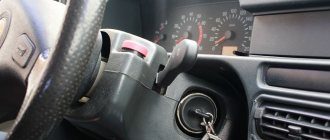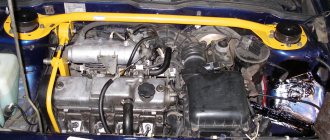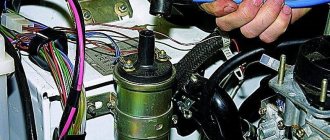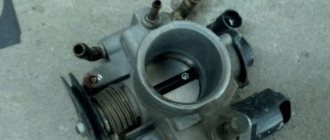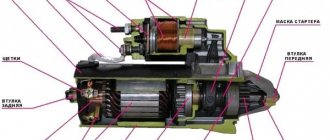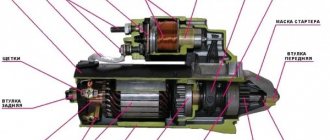1—for a week now, some crap has been going on in the mornings. It won’t start the first time, but the fuel pump pumped up the gasoline, everything is fine, I start it and it still has holes in it two or three times and stalls. I repeat the procedure ——- holes in it and stalls. The computer is silent, not at all. errors. I checked the fuel pump purely like in the operating room. The third time with half a turn. —— But then comes the second crap. I plugged in the first one, left the yard, switched to netralka and the revs didn’t drop. I had to turn it off and start it again. (I’ve already changed 3 idle speed sensors) Either it’s the sensors or it’s a mystery of nature. Tomorrow I think I’ll deal with these problems. I'll let you know the results.
Well, I fixed it; the problem was in the spark plugs. Before this I changed the spark plugs and installed NGK ones. and got hemorrhoids. I returned the BOSH SUPER PLUS back. and how the grandmother whispered. I don’t want to say anything bad about NGK, it’s just random. In general, I’m once again convinced that if it works, there’s no point in messing with it.
What is the reason why the injector takes a long time to start? The problem can be caused by various reasons, because the engine takes a long time to start not only when cold, but also when hot. Could this mean that the starter rotation time has nothing to do with temperature or not?
Finding the reasons for a poor hot start
Dear friends. For a long, long time since I bought the car, I have been plagued by the same problem - poor starting of the engine when hot after 10-20 minutes of inactivity. Cold starts are just perfect. When it’s hot, you have to press the gas pedal to get it, it can turn for up to a minute, but then it grabs.
The injectors were cleaned, the two-pin DOT sensor was changed, the fuel pressure sensor was replaced, the spark plugs + armored wires were replaced, and a new fuel pump. But the reason never went away.
The last thing I did was replace the brains, from 2111-14110-20 to 2111-14110-20-70. The DD has been changed to a new Euro model. But the problem doesn't go away.
Tell me where to dig next?
HBO for cars
A hot engine can also cause a breakdown in the case of an installed gas system. Since driving on gas has recently become profitable, many drivers switched to this type of fuel, however, they did not take into account some of the nuances of the new system. In hot weather, gas expands more, which leads to increased pressure inside the system and often causes damage. This is why it is bad to drive on gas in the heat.
At high temperatures, seals and hoses can fly off, which leads to gas leakage.
The result is an extremely dangerous situation. To avoid this, try not to fill the tank to full gas in the summer, this will reduce the pressure in the system and the risk of breakdown. If a similar problem occurs, it is recommended to let the car cool down and then visit a service station. You should not repair the gas system yourself; the equipment should be adjusted by a specialist.
Ignition
When a car does not want to start, then most likely there is a problem in its ignition system. This reason, as practice shows, is extremely common. Most often, the lock breaks; somewhat less often, troubles occur with:
Interestingly, a low battery usually does not interfere with a hot start, but in winter even a full charge may not be enough. Check the voltage supplied by the battery with a tester - normally it should be approximately 11.5 volts.
The problem in question often arises precisely because of the ignition switch. Here, contact deteriorates over time, and this, in turn, does not allow the system’s electrical circuit to be activated. It’s easy to check the functionality of the 2115 model:
If there is no contact, the element is replaced.
Please note that if you do not hear a clunking noise when starting the car, then the ignition relay is most likely broken. It is located in the 2115th model near the driver's door, above the clutch. The element cannot be repaired; it must be replaced.
The ignition coil is checked separately - due to its failure, in particular, the spark on the spark plugs disappears. For testing, the unit must be dismantled. Next, use a multimeter to ring the windings. A short circuit in them or a break is a completely obvious reason explaining the reluctance of the car to start.
Injector problems
Why doesn’t the car start when it’s hot if, for example, it has an injection engine? There are also a lot of problems with such cars, mainly due to sensors, but there are also other problems. There are several options here:
- Coolant sensor malfunction. Since the injection system is almost completely automated, its operation depends on the readings of sensors located in the gas tank, engine and other components. As soon as the reading device produces incorrect information, the entire system begins to malfunction. For example, problems in the readings of the coolant sensor lead to the fact that the ECU, which reads the device information, gives the wrong command to other operating elements. As a result, the wrong amount of fuel enters the chamber, which is why it is impossible to create a combustible mixture. The solution to the problem is to disconnect the sensor, clean it, or replace it if it is damaged.
- Problems with injectors. This is an extremely rare case of malfunction, but it does happen. The breakdown consists of a breakdown of the injector, and for this reason fuel is not supplied. The lack of pressure inside the channel leads to the fact that fuel does not enter the combustion chamber. The injectors need to be replaced.
- Faulty air flow sensor. As in the first case, it can easily fail, which disrupts the operation of the system for creating a combustible mixture. As a result, the fuel is either too rich in oxygen, or, conversely, poor. In both cases, fire does not occur, and therefore the engine does not start. The following symptoms accompany the problem: surges in engine power, strange sounds when starting the engine, the sound of a strong exhaust from the gas exhaust system, failures when pressing the gas. Replacing the device and adjusting the entire system should help.
Fuel system 2115
When the Lada does not start hot or cold, and none of the above options helped to find the problem, then the reasons may lie in the components and communications responsible for supplying the engine with fuel.
In the case of the 2115th model, the following may happen:
The easiest way to find out if the gasoline pump is working is this:
If nothing disturbs the silence, then the pump will have to be removed.
Next, the pressure in the fuel line is checked for a car that does not want to start. Install the pressure gauge into the fitting provided for it. On the VAZ-2115, the normal value ranges from 2 to 2.5 atmospheres. When the pressure is lower, the car does not start or stalls while driving. Check the connection points of the pipes - it may be leaking there.
Sometimes the filter also turns out to be faulty - it becomes clogged due to low-quality fuel. As a result, gasoline is not supplied in the required quantity, the pressure drops and the engine does not start. This problem can manifest itself during both hot and cold starts.
Bad fuel also clogs the injectors - this is another frequent breakdown for VAZ. These elements sometimes stop working due to a break in the wires supplying them. The contact may disappear in the armored cables leading to the candlesticks.
Carburetor problem
Most often, cars with a carburetor suffer from problems starting when hot. This happens due to the design features of the unit. The main reason here is overheating.
During operation, the carburetor is cooled by the external environment - air and fuel fluid that pass through its structure. While the engine is running, the carburetor is still cooling, so everything is fine. As soon as the engine is turned off, the flow of air and fuel to create the air-fuel mixture stops. Where does overheating come from? The fact is that the engine is still hot, which is why the carburetor temperature also increases. The gasoline that remains in the carburetor chamber begins to evaporate with a constant increase in temperature.
Gasoline vapors penetrate all channels that are connected to the float chamber, causing plugs to form.
The carburetor, air filter, and fuel lines become clogged. Since the channels through which fuel flows become clogged, the fuel level drops to insufficient to start the engine.
For different car models with a carburetor, this problem may have its own character, so the severity of each individual case will be different. In some cases, the engine can be resumed after several test runs. When the jams in the system disappear, the engine will start working again. Sometimes attempts can take up to half an hour, after which the car will still be running. Manual pumping of fuel helps with the problem perfectly.
This problem is typical only for cars with a carburetor.
Starter
In a situation where the car does not start, and the previously described components are in order, then a faulty starter is probably preventing normal starting. This could happen to him:
The terminals of the cables connected to the starter often become oxidized and dirty. This is the most possible factor preventing the VAZ car of the model in question from starting. If cleaning does not help, then it is possible that there is a break somewhere.
Bearings, as well as brushes and windings are checked when it turns out that voltage is supplied to the starter, but it does not turn. It will have to be removed and disassembled. And sometimes the solenoid relay fails. More often than not it just jams. It helps to bring the device back to life by gently tapping it, for example, with a key.
In general, it is not difficult to find out whether the relay of your VAZ-2115 is functioning. Connect its positive output directly to the corresponding wire coming from the battery.
Nothing happens when I turn the key
On a VAZ 2114 , this usually indicates a violation in the ignition switch-starter line, however, one of the reasons for the breakdown “for blondes” is a dead battery, remember this (checked with a voltmeter: there will be more than two 11.8 V - and a hydrometer, if the battery is serviceable: two or more than 1.22 in each jar).
The VAZ 2114 injector does not start well.
Let's move on. The cause of this malfunction may be a breakdown of the ignition switch cylinder, but the injector has nothing to do with it. If, when turning the key, new sensations arise (something catches, turning has become easier, as it is also called, on the contrary, more difficult), this is the problem.
Under the panel, approximately above the clutch, there are two relays: ignition switch and starter release. The reason you will like the malfunction of one book among them. They are checked according to the manual by a good electrician, in other words, by replacing it with a known working one.
Other reasons
Malfunctions of this kind are much less common on the VAZ-2115:
In the first and last case, you will have to disassemble the engine and replace unsuitable parts. If you are not sure that you can cope with this task, then it is better to entrust it to specialists from a car service center. It’s quite possible to install the belt yourself.
Sometimes problems in the VAZ-2115 arise with hot starts. There is a possibility that the air filter is the culprit. Check it and the lines that are connected to it.
Problems of domestic cars
Many domestically produced cars also have trouble starting when the engine is hot. The problem is in the design, but this time the gas tank. The fuel pump, which heats up during operation, should, in theory, cool down a little during operation. This occurs due to the liquid that moves through its body. During the summer heat, the liquid heats up, so cooling does not occur, which leads to disastrous consequences.
A faulty high-pressure fuel pump (HPF) stops working, which leads to a disruption in the fuel supply to the engine. Subsequent turns of the key and pushes will not help, but there are several “old-fashioned” methods. The device needs to cool down.
- Wet a cloth in cold water and apply it to the fuel pump housing until it cools down.
- Roll the car to a cool, sheltered place from the sun, open the hood. Wait a while for the unit to cool down. This usually takes 15–20 minutes.
Doesn't start well when hot
Hi all. Auto vaz 2115 8kl. The crux of the problem is in the title. The problem is floating, it happens 2-3 times a day, it happens once a week. Anyway, I’ve arrived and I’m jamming. I come back in 5-10 minutes and start starting it. It starts, but the speed is around 500, it does not respond to gas, there are no errors. I turn it off, immediately start it again and as if nothing had happened it works perfectly. The other day even restarting didn't help. I dropped the car off, came back an hour later and started again without any problems. After that I decided to change the fuel pump grid. It was very dirty. Still the problem did not go away. Tell me who has encountered a similar problem, in which direction to dig and where to look. Thanks to everyone who won't pass by.
I don't know, on my 07 sensor XX the brain is soaring, wash it and install it and everything is fine. But it gets dirty from the gases coming from the crankcase. In principle, there is no desire to install a new one, it will be the same story. I drive it that way. Sometimes it won't start, sad thing. I pressed it a little and started it, but it didn’t hold the speed, I revved it up a little and everything fell into place... the fuel pump. Perhaps I don’t know what system you have, how it works... (relatively speaking)...more likely a fuel pressure sensor, but is there one on 8. ask someone to help for a couple of minutes. when it doesn’t start, press the spool valve on the ramp - is there pressure? ? and try (assistant) to start the pump - does it pump? Just because it hums doesn’t mean it pumps up the required pressure. Buy a regular tire pressure meter and measure it with it, I don’t know what current you should have - find it in the literature. It’s in the fuel pump itself some kind of valve, or rather a non-return valve, so it can float together with a pressure sensor - I had this on my Volvo - the sensor says “hare”, but it didn’t hold us and didn’t pump it up. Try to measure the pressure when you turn it off and after stopping after 15 minutes, on a Volvo during this time, the norm is 3.7 kgf/cm2
Source
After starting, the engine stalls immediately: why does this happen?
During the operation of a car, a common situation is that after turning the ignition key, the car starts, the engine starts to work and stalls after a few seconds. As a rule, 3-5 seconds pass from the moment of starting to stopping the internal combustion engine. Before the engine stops completely, engine vibrations are also noticeable, the power unit shakes and operates very unstable.
This happens as a result of a decrease in speed, the resonance effect of a rotating crankshaft, etc. When you try to start the engine again, the engine may no longer start, or the situation described above may repeat again.
The reasons for this problem vary. The main thing is that if the car starts and stalls, this indicates that in-depth diagnostics are needed. Next we will talk about what to do in such a situation, as well as how to find the reason why the engine stalls after starting.
Finding the reasons for a poor hot start.
Dear friends. For a long, long time since I bought the car, I have been plagued by the same problem - poor starting of the engine when hot after 10-20 minutes of inactivity. Cold starts are just perfect. When it’s hot, you have to press the gas pedal to get it, it can turn for up to a minute, but then it grabs.
The injectors were cleaned, the two-pin DOT sensor was changed, the DMVR was replaced, spark plugs + armored wires were replaced, a new fuel pump
. But the reason never went away.
The last thing I did was replace the brains, from 2111-14110-20 to 2111-14110-20-70. The DD has been changed to a new Euro model. But the problem doesn't go away.
Tell me where to dig next?
Introduction
Due to the cooling system, the vehicle is able to very quickly reduce the temperature of the main engine parts heated during operation and other components that are subject to overheating. It is worth noting that not only the parts are cooled, but also the gas and oil. Using a simple device, the engine is protected from severe overheating. With the help of various coolants, which are antifreeze and antifreeze, “traveling” through special channels, heat is taken and subsequently cooled in the system radiator. However, the functionality of the unit may be impaired, which is most often caused by the appearance of an air lock. In the material below, we will consider three effective methods that have proven their effectiveness in practice and can help any motorist whose VAZ-2115 stove has become airy.
VAZ 2115 injector 8 valves does not start when hot - reasons
WILL NOT START AND STALL WHEN STARTING A HOT VAZ 2115
On a VAZ 2115, it starts perfectly when cold, but when starting hot, it immediately stalls. After it cools down, it starts without problems. What could be the reason?
Poor hot starting is one of the diseases of VAZ cars. Therefore, the question is very common. This happens due to the low quality of spare parts and some design features. It happens that the fuel pump is replaced with a new one, but it turns out to be faulty. “In search of a malfunction” everything is changed, and the problem is revealed already on the second round.
If the car does not start when hot, we recommend checking using the following algorithm:
The rest of the information is for the remaining 20% (diagnostics does not reveal problems) and those who do not have qualified specialists in the access area.
INFLUENCE OF SENSORS
Most VAZ-2115 cars operate on the “January 5.1” controller. Crankshaft, temperature and throttle sensors are involved in starting the engine.
DPKV malfunctions usually appear regardless of temperature, but it is worth checking its resistance and comparing it with the data in the calibration table.
A more common malfunction is DT. Remove from position and place in a container with a cooler. We measure the resistance with a multimeter: it should be in the region of 1350 - 1880 Ohms. If you have a thermometer, you can check it using the table. If not, it doesn’t matter either, just heat it to an arbitrary temperature. As T increases, the resistance decreases. On a fully warmed up engine it is 87 - 109 Ohms. If the ohms do not change or drop to 0, change the DT.
The throttle assembly is completely disassembled and cleaned. One of the problems is dirt, which expands when heated and interferes with the normal operation of the injection. If the TPS malfunctions, the car not only does not start when hot, but also “does not drive” (sometimes stalls and does not start) after warming up.
The TPS is checked with an ohmmeter with the engine running. Place the multimeter on the input and output contacts, ask an assistant to press the gas. The readings should change and return to their original values at XX. If the resistance does not change when you press the pedal or the device shows infinity, the sensor needs to be replaced. At the same time we check the IAC. It usually causes the car to be unstable at idle or stall but start.
A malfunction of the mass air flow sensor on cars with January 5.1 is recognized by the fact that the car starts when hot and immediately stalls. The sensor comes into operation only after startup. But on a car with January 7.2, the mass air flow sensor is involved in the start - without it the car will not start.
FUEL PUMP AND RELATED ACCESSORIES
The first malfunction is insufficient pressure in the fuel rail. During operation, the pump heats up and begins to pump poorly. Because of this, the car may stall and not start.
The pressure is checked by installing a pressure gauge. At idle in the system 2.5 atm, in power modes it should increase to 3. With a faulty pump, these indicators may differ between a cold and hot engine. Check in the mode in which problems arise.
One of the problems of the VAZ 2115 is the bypass valve, which, if faulty, begins to “let in” fuel on a heated engine. Bottom line: fuel pressure drops and takes time to build up. Symptoms are a long period of production or its complete absence.
Another reason for a drop in pressure in the system may be a clogged fuel filter or strainer in the tank. When heated, dirt expands and clogs the fuel flow.
IGNITION MODULE
Another problem is the ignition module. This malfunction was more common on cars of the Samara-1 generation. In the case of Samara-2, the quality of the part itself has improved, but the root of the problem remains. The module is attached to the cylinder block, which causes it to get very hot and burn out the windings. As a result, when hot, it is possible to lose spark in one, several or all cylinders at once.
If the car does not start when hot, check the spark. If it doesn't, that's almost certainly the problem. You can usually resolve the issue by replacing the module, but if the problem returns, consider moving the bracket to another location. Most often it is installed in the front part of the engine compartment, near the radiator.
Most problems with poor engine starting when hot are solved using these methods. But less probable ones are also possible: broken wiring, ECU malfunction, etc.
If you find an error, please select a piece of text and press Ctrl+Enter.
Source
Diagnostics
Diagnostics why the car takes a long time to start the injector
So, to determine the specific reason for the long start-up of an injection-injected internal combustion engine, you should start with a high-quality diagnosis. Usually, they check the compression in the cylinders. Its values must be within 12 atm for this to be considered normal. In this case, there should be no deviations between these indicators in each of the cylinders (maximum - 1 atm).
Then the spark plugs must be replaced. This will have an effect on the engine and it will now start much faster. However, if everything is not in order with the motor, then the normal starting time will last only 1-2 days.
Therefore, high-voltage wires should also be diagnosed. Diagnostics will make it possible to find out whether the cables have a breakdown, which is clearly visible by the spark coming out at night. This is done as follows: the car starts in the dark, at the same time you need to monitor which wire sparks.
The ignition coil also needs to be checked. Many experienced drivers do this: they install a known good and new module instead of the original one, then check the engine starting for several days. If everything is normal, the start-up does not take long - it means that the whole problem was in the bobbin (ignition coil).
If there are no changes, the test continues. This time you should test all filters, including the air filter. Next is checking and replacing all sensors and regulators. Pay special attention to the mass air flow sensor.
The next stage: testing various connections, checking the wiring for good contact, cleaning the masses and flushing the throttle assembly.
If nothing changes again, then it is recommended to check the engine fan relay. It often causes similar problems with starting on a fuel-injected internal combustion engine. You can test the relay if you remove the wire from the temperature controller installed on the thermostat.
Engine fan relay
The fan should turn on after these steps. However, after measuring the resistance value on a warm internal combustion engine, the system can produce low temperature data, although the temperature inside the engine is clearly more than 90 degrees. Why is there such a difference? It turns out that this may well be a buggy DTOZH, which for some reason was not checked earlier. It must show the real coolant temperature, otherwise chaos will begin in the system, and it is not surprising that the engine takes so long to start.



